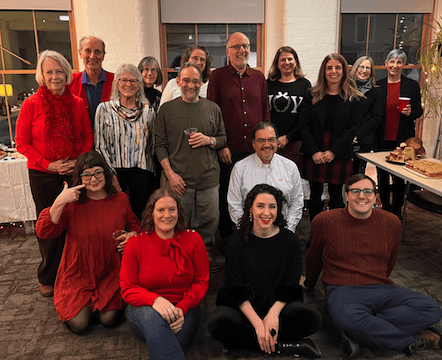This is a topic I’ve struggled with for years, but I think I now have a definitive answer to the question:
The best way to learn a language is to do both.
I know, I’m hilarious. But wait, there’s more to it than that. There is definitely a time and a place for studying in your hometown, in evening or daytime language classes, the kind that run a couple of times a week for a couple of hours each time. And there’s a time where studying languages abroad in a country where the language is spoken natively, really makes sense.

I worked in a language school and language travel agency for 12 years, and during that time we trained thousands of language learners in over fifteen different languages and at all levels. What always struck me as being unusual was that people would tend to EITHER learn a language through local language classes near them OR by going abroad to learn the language in a country where it’s spoken, but rarely BOTH.
We concluded that this was because there tends to be a mindset that you either prepare for a trip abroad in say South America or Spain by learning some Spanish before you go OR you make language learning a part of the trip, where you have a cultural and linguistic anchor point in the form of the friendly local language school and the opportunity to meet new people and even stay with a host family.
Having just spent the last 7 weeks learning Spanish in Spain (in San Sebastian – Donostia), I’ve seen quite a few other people come and go through the school, at different levels too. And that got me thinking, about:
What is the right language level to obtain before you go on a language course abroad?
I’m going to go out on a limb here, and say that I believe the best time to take a language course abroad is when you have at least a good A2 or B1 level of language proficiency. Before I explain why, let’s look at what you’ll typically be able to do at each of those levels.
What language can you use at A2 (Elementary) level?
At the A2 level, you have a basic ability to communicate in everyday situations using familiar, routine expressions. You should be able to introduce yourself, ask and answer simple questions about personal details such as where you live, people you know, and things you have. In conversation, you should be able to handle short exchanges, especially when the other person speaks slowly and clearly and is willing to help.

In terms of grammar, A2 learners have a limited but growing understanding of sentence structure. Ideally, you can form simple sentences in the present tense and may use some past and future forms, but often with errors. Common structures like subject-verb-object sentences, questions, and basic negatives are generally understood. You should have a handful of frequently used verbs (like “to be,” “to have,” and “to go”) that you can conjugate, and you might be able to link ideas together with connectors like “and” or “but.” However, you’re likely to be struggling with irregular verbs and more complex tenses, especially in questions or longer sentences.
While writing and speaking at this level may lack fluency and precision, A2 learners are capable of getting their point across in familiar contexts using memorized phrases and basic constructions.
What language can you use at B1 (Intermediate) level?
At B1 you’ll be able to function more independently in a range of everyday and work-related situations. You’ll understand the main points of conversations or written texts on familiar topics such as travel, work, or hobbies. In speech and writing, you’ll be able to describe events, express opinions, and give reasons or explanations, though not always with complete accuracy or ease.
Grammatically, you’ll have a stronger grasp of verb tenses and sentence structure. You’ll use the present simple, past simple, and future constructions with some confidence, and you’ll begin to work with more complex tenses such as the present perfect and past continuous. You’ll form questions more accurately and start experimenting with conditionals (e.g., “If I had time, I would…”) and relative clauses (e.g., “The book that I read…”). While you may still make mistakes with irregular verbs, word endings, and prepositions, your errors usually won’t prevent understanding.
At this stage, you’ll start to show greater flexibility with language. You’ll connect ideas with a variety of linking words (“however,” “because,” “although”) and manage longer utterances in both spoken and written formats. Your language use will be more varied and creative, though you may still rely on familiar topics and hesitate when dealing with more abstract or nuanced subjects.
Why is it best to be at A2 or B1 level of language before you study the language abroad? (And what if you’re not?)
When you think of language learning like any other form of knowledge acquisition, you need to be like a sponge: you need to absorb as much language ‘stuff’ as possible so you can then use it yourself going forwards.
But taking the metaphor forwards, moving up through the levels, for me, is like getting a bigger sponge. The more you know about language structures, grammar, common verbs, basic vocabulary sets, the more space there is in and between those learned structures to absorb new information. Inversely, if you’ve only got a little beginner sponge, you can very quickly get inundated when you’re in a full immersion situation.
Of course, being fully immersed doesn’t mean you’re going to drown. It just means that you’re more quickly saturated, and you might feel you need to shut down your sensors and therefore not be so aware of everything that is happening around you.
And that’s my argument really. Part of the pay-off of the cost of going abroad to improve your language skills is this extra layer of immersion that you can brush up against: from shop signs to overheard conversations, to your social media ads switching to the local language(!), listening to your teacher, needing to use the local language to communicate with classmates, ordering food and drink, and interacting in bars and restaurants.

At sub-A2, it still feels luxurious and exciting to be abroad – for all the reasons most of us love a good foreign holiday – and indeed when you don’t understand what’s going on around you it actually makes it feel ‘even more exotic’. But in terms of a language learning method, it’s possibly not that efficient, that’s all.
With that slightly higher level of A2 or B1, I think you’ve got a bigger sponge – much more of a framework to hang language off, to recognise some of the structures you’re hearing, to grab vocabulary and remember it because it connects to something you already know.
What are the advantages of learning a language in your local language school at home?
Let’s now look at the flip-side, learning a language in a school near you. I’m most familiar with the language classes at ILI, my home away from home in the States.
There are some definite advantages of studying at home, maybe a couple of times a week in daytime or evening language classes:
Little and often
There are many academic arguments to support the idea that the more gradually you build up your language skills, the stickier that knowledge is going to be. The whole objective of learning a language is that you get yourself to a point where you can actively draw upon the words and phrases – and apply the grammar structures you need – instantaneously when needed.
Now can we just pause to recognise how awesome you are if you’re doing this already in a second language. It is a true feat of mental dexterity. Academics like Stuart Webb and Paul Nation, voices of authority on vocabulary acquisition believe you can have receptive knowledge (you recognise the word when you hear or read it) after maybe 5 to 10 exposures to the word or phrase. However, to get to productive knowledge (where you can recall and use the word correctly in speech or writing) typically needs more – around 10 – 20 well-distributed, varied encounters.
It’s simply much easier to build up that kind of exposure when you’re in a local language school class where the same people are together for the duration of the program. A good teacher will continually remind you of the vocab learned in previous weeks, and the regular repetition over time and in different contexts is what will make language stick.
At lower levels, I’d argue that developing this kind of solid base is particularly important. One of the few downsides of a language course abroad is that, with new people joining and leaving your group, teachers will generally find it harder to recycle vocabulary for more than a week at a time.
Listening comprehension
When the French want to say they’re not very good at languages, they say they “haven’t got the ear for it”.
The hardest thing for me learning Spanish in Spain has been listening comprehension – my ability to understand what people are saying to me, or around me, when they’re speaking at a full pace. We forget how fast we talk in our own language, and the wonderful thing that our amazing language teachers do without us realising it, is that they speak at a pace that is appropriate for our level.
Again, the higher the level you’ve banked before you arrive, the more you’ll have worked on your listening comprehension, and the better prepared you’ll feel. I’m going to argue that over the weeks of your local language class at home, your teacher will have got to know you really well, and they will be highly adept at speaking the language at just the right level to keep you on the edge of your seat, but give you plenty of comprehension wins at the same time!
The same local language
I’m not advocating you play this joker card too often, but there is a security to knowing that your other classmates – and your teacher for that matter – will speak your language as well as the language they’re teaching. It’s a safety net, and it can, certainly at the early stages of learning a language, really help you to get a grip of new grammar rules and get a quick translation of a new word that is confusing you.

That said, ILI teachers are trained to deliver the entire lesson in the language you’re learning, to emulate as much as possible an immersion situation. However, if you’re the kind of person who just likes that little nod of confirmation that you’ve understood it correctly, then that’s going to be a lot easier on home soil.
Time for a conclusion?
In the end, language learning is a deeply personal journey, and there’s no one-size-fits-all approach. All I’ve done is share my thoughts and in truth, what feels right for you in terms of the best way to study a language is likely to be the best route forward.
Studying a language locally allows you to build a strong foundation at your own pace, with the support of skilled teachers and classmates who share your goals.
Traveling abroad offers the thrilling challenge of real-world immersion, where the language comes alive in everyday moments and cultural exchanges.
What’s lovely about ILI is that they’re all about cross-cultural understanding and the mutual appreciation of each other’s native language. This reflects the deep acceptance of people that I’ve seen every time I’ve been in this rich and vibrant language school, quietly doing its thing in downtown Northampton, Massachusetts.
Whether you study in their World Language Program at home, or travel overseas to learn in-country, the thread of connection, expanded world view, self-confidence and self-belief runs through every experience. So you’re in safe hands either way.
Related Articles
- Expanding Vocabulary Abroad: Strategies for Building a Rich French Lexicon
- Maximize your dollar: Budget tips for Spanish language students in Colombia
- Our Top 4 Destinations to Learn Spanish Abroad
- German Immersion: The Ultimate Beginner’s Guide to Learning German in Germany
- A Beginners Guide on French Culture and Learning French in France
- Spanish with a Side of Pintxos: San Sebastián Language Journey
